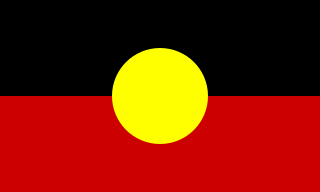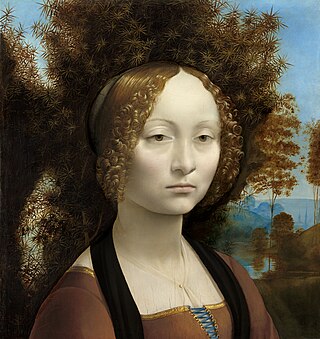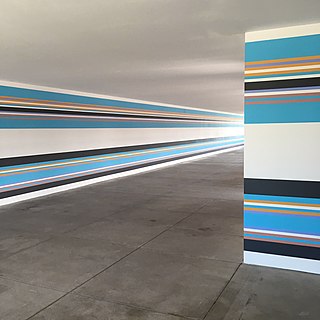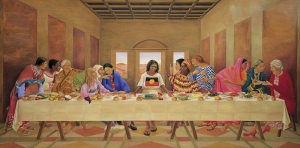
The Last Supper is a mural painting by the Italian High Renaissance artist Leonardo da Vinci, dated to c. 1495–1498, housed in the refectory of the Convent of Santa Maria delle Grazie in Milan, Italy. The painting represents the scene of the Last Supper of Jesus with the Twelve Apostles, as it is told in the Gospel of John – specifically the moment after Jesus announces that one of his apostles will betray him. Its handling of space, mastery of perspective, treatment of motion and complex display of human emotion has made it one of the Western world's most recognizable paintings and among Leonardo's most celebrated works. Some commentators consider it pivotal in inaugurating the transition into what is now termed the High Renaissance.

The Australian Aboriginal flag is an official flag of Australia that represents Aboriginal Australians. It was granted official status in 1995 under the Flags Act 1953, together with the Torres Strait Islander flag, in order to advance reconciliation and in recognition of the importance and acceptance of the flag by the Australian community. The two flags are often flown together with the Australian national flag.
Yo Mama's Last Supper is a work of art, made in 1996 by Jamaican-American artist Renée Cox. It is a large photographic montage of five panels, each 31 inches square, depicting photographs of 11 black men, a white Judas and a naked black woman posed in imitation of Leonardo da Vinci's 1490s painting The Last Supper. Cox is pictured naked and standing, with her arms reaching upwards, as Jesus.

Ginevra de' Benci is a portrait painting by Leonardo da Vinci of the 15th-century Florentine aristocrat Ginevra de' Benci. It was acquired by the National Gallery of Art in Washington, D.C. US from Franz Joseph II, Prince of Liechtenstein in February 1967 for a record price for a painting of between $5 and $6 million. It is the only painting by Leonardo on public view in the Americas.

Margaret Rose Preston was an Australian painter and printmaker who is regarded as one of Australia's leading modernists of the early 20th century. In her quest to foster an Australian "national art", she was also one of the first non-Indigenous Australian artists to use Aboriginal motifs in her work. Her works are distinctively signed MP.

Emily Kame Kngwarreye was an Aboriginal Australian artist from the Utopia community in the Northern Territory. After only starting painting as a septuagenarian, Kngwarreye became one of the most prominent and successful artists in the history of Indigenous Australian art. She was a founding member of the Utopia Women's Batik Group and is known for her precise and detailed works.

The Virgin and Child with Saint Anne and Saint John the Baptist, sometimes called the Burlington House Cartoon, is a drawing by Leonardo da Vinci. The drawing is in charcoal and black and white chalk, on eight sheets of paper that are glued together. Because of its large size and format the drawing is presumed to be a cartoon for a painting. No painting by Leonardo exists that is based directly on this cartoon, although the drawing may have been in preparation for a now lost or unexecuted painting commissioned by Louis XII. The drawing is the only extant larger-scale drawing by the artist.

Nancy Graves was an American sculptor, painter, printmaker, and sometime filmmaker known for her focus on natural phenomena like camels or maps of the Moon. Her works are included in many public collections, including those of the National Gallery of Art, the Brooklyn Museum of Art, the Smithsonian American Art Museum, the National Gallery of Australia (Canberra), the Des Moines Art Center, Walker Art Center (Minneapolis), and the Museum of Fine Arts. When Graves was just 29, she was given a solo exhibition at the Whitney Museum of American Art. At the time she was the youngest artist, and fifth woman to achieve this honor.

The absence of women from the canon of Western art has been a subject of inquiry and reconsideration since the early 1970s. Linda Nochlin's influential 1971 essay, "Why Have There Been No Great Women Artists?", examined the social and institutional barriers that blocked most women from entering artistic professions throughout history, prompted a new focus on women artists, their art and experiences, and contributed inspiration to the Feminist art movement. Although women artists have been involved in the making of art throughout history, their work, when compared to that of their male counterparts, has been often obfuscated, overlooked and undervalued. The Western canon has historically valued men's work over women's and attached gendered stereotypes to certain media, such as textile or fiber arts, to be primarily associated with women.

Elizabeth Durack Clancy CMG, OBE was a Western Australian artist and writer.
Papunya Tula, registered as Papunya Tula Artists Pty Ltd, is an artist cooperative formed in 1972 in Papunya, Northern Territory, owned and operated by Aboriginal people from the Western Desert of Australia. The group is known for its innovative work with the Western Desert Art Movement, popularly referred to as dot painting. Credited with bringing contemporary Aboriginal art to world attention, its artists inspired many other Australian Aboriginal artists and their styles.

Feminist art is a category of art associated with the feminist movement of the late 1960s and 1970s. Feminist art highlights the societal and political differences women experience in their lives. The goal of this art form is to bring a positive and understanding change to the world, leading to equality or liberation. Media used range from traditional art forms, such as painting, to more unorthodox methods such as performance art, conceptual art, body art, craftivism, video, film, and fiber art. Feminist art has served as an innovative driving force toward expanding the definition of art by incorporating new media and a new perspective.

The 16th-century portrait Mona Lisa, or La Gioconda, painted in oil on a poplar panel by Leonardo da Vinci, has been the subject of a considerable deal of speculation.
Susan Dorothea White is an Australian artist and author. She is a narrative artist and her work concerns the natural world and human situation, increasingly incorporating satire and irony to convey her concern for human rights and equality. She is the author of Draw Like da Vinci (2006).

Makinti Napanangka was a Pintupi-speaking Indigenous Australian artist from Australia's Western Desert region. She was referred to posthumously as Kumentje. The term Kumentje was used instead of her personal name as it is customary among many indigenous communities not to refer to deceased people by their original given names for some time after their deaths. She lived in the communities of Haasts Bluff, Papunya, and later at Kintore, about 50 kilometres (31 mi) north-east of the Lake MacDonald region where she was born, on the border of the Northern Territory and Western Australia.

Bronwyn Bancroft is an Aboriginal Australian artist, administrator, book illustrator, and among the first three Australian fashion designers to show their work in Paris. She was born in Tenterfield, New South Wales, and trained in Canberra and Sydney.
BarbaraWeir is an Australian Aboriginal artist and politician. One of the Stolen Generations, she was removed from her Aboriginal family and raised in a series of foster homes. In the 1970s Weir returned to her family territory of Utopia, 300 kilometres (190 mi) northeast of Alice Springs. She became active in the local land rights movement of the 1970s and was elected the first woman president of the Indigenous Urapunta Council in 1985. After starting to paint in her mid-forties, she also gained recognition as a notable artist of Central Australia. She also managed the artistic career of her own mother, Minnie Pwerle, who was also a noted artist.

The Last Supper (1630–1631) is an oil painting by Peter Paul Rubens. It was commissioned by Catherine Lescuyer as a commemorative piece for her father. Rubens created it as part of an altarpiece in the Church of St. Rombout (Rumbold) in Mechelen. The painting depicts Jesus and the Apostles during the Last Supper, with Judas dressed in blue turning back towards the viewer and away from the table. Other than Jesus, the most prominent figure is Judas. Judas holds his right hand to his mouth with his eyes avoiding direct contact with the other figures in the painting creating a nervous expression. Jesus is dressed in red and has a yellow halo surrounding his head with his face tilted upwards. Jesus is located centrally in the painting surrounded by his disciples with six on each side, and he holds a loaf of bread with a cup of wine in front of him. Out of all of the figures, he is the most in the light with the figures to the farthest left being the most in shadow. "The scene thus represents a perfect conflation of the theological significance of the Last Supper" meaning the conflation between the blessing of the bread and the wine while still being pivotal in the sense of revealing the betrayal.

Portrait of Dorothea Berck is a 1644 painting by Frans Hals that is in the collection of the Baltimore Museum of Art. It depicts Dorothea Berck at age 51, the wife of the prosperous Haarlem merchant Joseph Coymans, whose portrait Hals also painted. Both paintings were executed on the occasion of their daughter Isabella's wedding, whose marriage pendants Hals also painted.
Dolly Nampijinpa Daniels (1936–2004) was an Australian Aboriginal ritual leader, Warlipiri speaker, renowned artist, and land -rights advocate for the Warlipiri people of the Northern Territory.















